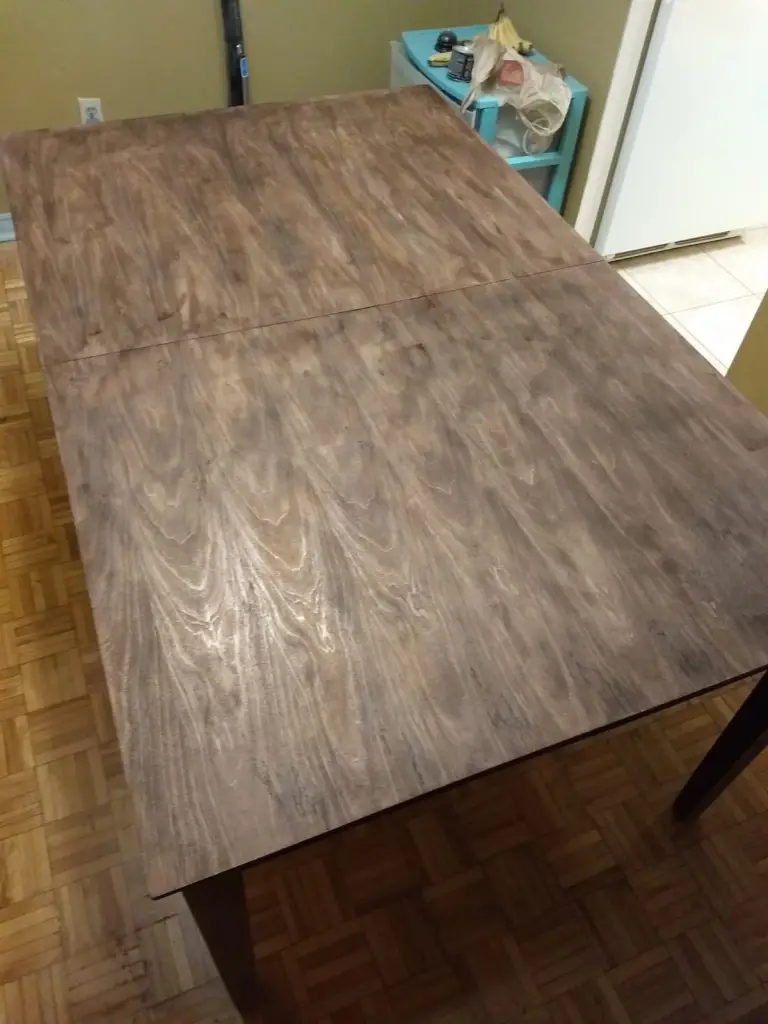One of the critical steps when staining any surface is sanding. It doesn’t matter whether you’re applying one coat or more. You need to sand between coats, except in some not-too-common instances. When sanding after staining, painters and woodworkers must use the best product and apply, following the proper techniques.

Here’s what I found:
Should You Sand Wood Between Coats Of Stain?
You need to sand between coats of water-based stains, not oil-based ones. Wait 4-8 hours for the last coat of stain to dry before sanding, then use 220-250 grit sandpaper to evenly sand and remove dust in the direction of the wood grain. Sanding helps to obtain an even and smooth surface.
This article offers a deep insight into when, how, and why to sand between stain coats. After all, every artist looks forward to an excellent stained project, a durable project that will hold out against the elements and last longer.
Let’s find out.
Table of Contents
You don’t have to sand wood between coats using oil-based or gel stains. You’ll only need to sand the surface and clean up sanding dust with these stain types before applying the stain.
On the other hand, you should sand between coats of stain if you’re using water-based stains. All you need to do is sand down every raised wood grain. Nevertheless, in using other types of wood stains, you only need to sand the surface before applying the first coat of stain. Woodwork can be said to achieve a better finish when the first and second coats of stain glue together before the final sanding.

What Happens if You Sand after Staining wood?
Sanding after staining will help even out the raised grained and any bubbles. But remember to use fine-grit sandpaper to get the desired results.
After sanding the surface of the wood to your satisfaction, you will notice a fine, smooth layer of dust on the wood. The reason is that the aggressive scratches of the sandpaper leave more scratches, so when you add stain on top of that, the color particles in the stain have more places to lodge and make the wood darken the more. At this point, do not wipe off with a wet rag.
Takes 4-8 Hours for The Stain to Dry before Sanding?
You should typically allow the stain to dry between 4 and 8 hours. But, the dry time depends on the stain type you choose. Water-based stains have a quicker drying time than their gel or oil-based counterparts. You need to ensure that the previous coat is completely dry before applying another layer of stain. Once dry, the surface won’t feel sticky, wet, or blotchy when your touch it. This way, you can be sure the stain is dry.
However, in all these, it is essential to follow the manufacturer’s recommendation about the length of time to wait between sanding and staining, as this will allow for proper absorption and a beautiful finish.
Two coats of stain are generally needed to apply on most wood works. This is because the stain is known to permeate through the material. However, it is essential to understand that the number of coats needed to use stain depends on the type, finish type expected, and the surface being stained. You should only apply the number of coats that the material can absorb. Always stick to recommended stain products and types.

Tools You Need for Sanding Wood?
Belt Sander –used to quickly remove a large amount of wood and adjust wood edges against walls. You can use it to shape and finish wood.
Random Orbit Sander – removes course scratches from wood and prepares the surface for finish sanding. Use a random orbit sander if you desire an ultra-smooth sanded plastic or wood surface.
Mouse Sander – used for final finish sanding. It is shaped with a sharp nose that penetrates doors and cabinets in tight spots.
Drill Drum Sander – specially designed for sanding round holes or curved features.
Sanding Block – designed to sand small pieces of wood and knock off sharp edges.
Sanding Wood after Staining before Polyurethane
Here are steps to sand wood after staining but before polyurethane:
Sand Wood Surface
The first step is to sand the surface of the wood with 220-250 grit sandpaper.
Using smooth sandpaper will help smooth any visible flaws on the stained wood surface. Using lower grit sandpaper might tear off the stain and end up with rough scratches that may be hard to remove. So, the best way to sand at this stage is to avoid sanding between stain coats using steel wool.
Use Sanding Tool
With a sanding tool, you can evenly sand the wood surface. If you don’t have a sanding tool, you should use a block of small scrap wood to wrap the sandpaper around. You can also hold the sandpaper with your bare hands. Keep your hand about 8 meters away from the wood surface.
Use Smooth Sandpaper
Gently sand the stain in the same direction with the wood grain and, at the same time, make soft touches on both ends of the natural wood. You will undoubtedly see pinches of dust on the sandpaper and the surface. You can also run your bare hands on the sanded surface. If it’s smooth, you can stop sanding but if it is still rough, then gently sand again.
Use Dry Cloth
This is where you should dust off the surface and then wipe it with a dry rag. If your project uses an oil-based stain, dip the rag into mineral spirits and clean the surface to ensure there is no more dust. Remember to use a wet cloth to wipe off the dust from the wood surface because the water will raise the wood grain, making you start sanding repeatedly.
Sanding Stained Wood Furniture
To sand off the last bit of previously stained finish, use palm sand with 150-grit medium sandpaper until the bare wood appears. After that, switch to fiber sandpaper to finally remove the color left by an old stain so that the wood can accept a new stain. Remove the sanding dust after applying the sandpaper to avoid a blotchy or sticky surface.
To avoid damaging your furniture, you must always sand in the same direction as the wood grain. Sanding against the wood grain will introduce unnecessary scratches.
Smoothing wood after staining is straightforward. Once you finish sanding the bare wood with the regular 220-grit sandpaper, wipe off the surface to remove some sanding dust left on the surface. After that, you should scrub the surface with a clean cloth soaked in mineral spirits; you can also use denatured alcohol.
Once you have completed this process, it is time to allow the surface to dry out completely. Start finishing the surface to allow the dust to settle. Then, apply the first coat of finish to your project and let it dry thoroughly.
How to Stain Wood Furniture without Sanding?
There are many techniques to stain wood furniture without sanding, but this approach is perfect for wood that has been stained but not finished.
Mineral Paint
You don’t need to sand beforehand with mineral paint because mineral paint is durable and stain-resistant.
Bonding Primer
Most quality bonding primers indicate that sanding is unnecessary and will stick to most glossy surfaces like metal, glass, or tile.
Liquid Deglosser
Liquid sandpaper helps to avoid sanding furniture. Liquid deglosser is applied directly on the wood surface. A chemical reaction happens when you use a new stain, and the new stain adheres to the old stain.
Clean Sanded Wood
You can start by blowing off dust using a brush, an air compressor, or even vacuum the dust. Then wipe the wood surface using a rag soaked in either water or mineral spirits.
You can also apply a tack cloth to clean the sanded wood before applying stains. Please ensure that you work in a well-ventilated environment and protect your face with a pair of goggles and a mask.
Types of Wood Stain and Whether It Needs to Be Sanded?
Here are the two types of wood stains and tips on whether they need sanding or not.
Oil-based Wood Stain
Most oil-based stains like lacquer do not need sanding, and this is for several reasons. One of the primary reasons is that oil-based stains effectively bond, meaning that paint bonding cannot be a problem. It can only be mildly sanded at the last stage while applying some finishing touches.
Water-based Stain
This type of stain, also known as Aniline Dye, comes in powder form and must be mixed with water before use. The stain is transparent in nature in that, no matter the number of coatings applied, the wood will not change its looks. To use water-soluble dyes, you need to add a darker color to achieve your desired appearance. However, an existing stain can be removed through sanding.
Varnish wood stain is also known as polyurethane, just like oil stain that quickly dries in a hard coat. This type of stain also works best as a binder. Varnish stains are more difficult to use because it takes less time to wipe off dust. Also, brushing the wood surface might bring unnecessary brush marks and excess dust because they are colored. Therefore, vanish wood stain does not need to be sanded.
Sanding Tips To Make Stain Look Great
Here are some tips to make your stain look great on the surface:
Sand by Hand
Sanding with the hand is usually the last stage before applying the stain. Though it takes less time, the hand sanding effect does not always leave rough surfaces. However, if there are some visible scratches, kindly change to slightly coarser grit and begin again.
Know When to Stop
Smooth sanding gives the wood an attractive appearance, mainly when used with an oil finish, but it can go wrong if you decide to use a stain. Most oil-based stains contain standard colors that permeate through wood surfaces, especially when rough sanding scratches. It’s recommended to use 220-grit sandpaper for sanding to achieve an excellent finish and make the stain look good.
Sand Diagonally
This means sanding opposite directions of the grain while using the grits. After sanding diagonally in one direction, switch to finer sandpaper and sand sideways in the opposite direction till the scratches from the previous grit disappear. Repeat this process again until you see all the scratches disappear.
Seal with Waterproof Glue
Sealing is also critical to prevent outdoor furniture from rusting on the end grain. The stained wood can breed fungi once exposed to the element. Sealing the grain end of the stained wood with waterproof epoxy glue is the best idea. They are easy to apply and clean up.
Final Words: How to sand the wood to get a smooth surface?
Sanding after staining is an essential step when staining or painting wood or any surface. The whole idea of sanding between coats of stain ensures a smooth and even finish. It also helps the stain bond to the surface, giving a lasting and durable stained project.
Unless for the areas identified above, you must always use sand, and fine-grit sandpaper should be your best pick to avoid damaging your project. Allow the stain coats to dry before sanding or applying the second coat of stain. In all, do not overlook or underestimate any of the necessary steps before and after sanding between coats.

My name is Mark, and I am a software engineer and the founder of OnWoodWorkingArt.
I grew up with a passion for woodworking and now have my woodworking studio with a group of like-minded friends who love to create woodworking. My dream is to have a more extensive workshop and be able to make woodworking my main business.